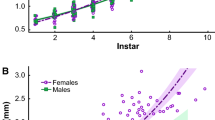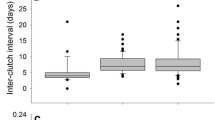Abstract
An end-of-season penalty, with late-maturing individuals being smaller than early-maturing individuals, has been observed in a variety of univoltine terrestrial arthropods. The current study extends these observations, utilizing multiple populations of a single sexually dimorphic species to examine the ecological correlates and fitness consequences of late maturation at a small size. The orb-weaving spider, Nephila clavipes, inhabits a broad range of habitats that vary from mild to strong seasonality. Because males mature several instars earlier than females, they can reach maturity much earlier in the growing season. Within a cohort, I found that female size at maturity was negatively correlated with timing of maturation in strongly seasonal sites. At a less seasonal site, there was no correlation between female size and timing of maturation within a cohort. In most populations studied, male size was not correlated with the timing of maturation within a cohort. Within populations in strongly seasonal sites, late-maturing females had reduced fecundity. The probability of copulation, survivorship from maturity to first clutch, clutch size relative to female size, and the number of possible clutches were all reduced with delayed maturation. The probability of pre-reproductive death for late-maturing females was strongly affected by stochasticity in the timing of the end of the growing season.
Similar content being viewed by others
Author information
Authors and Affiliations
Additional information
Received: 30 December 1998 / Accepted: 1 September 1999
Rights and permissions
About this article
Cite this article
Higgins, L. The interaction of season length and development time alters size at maturity. Oecologia 122, 51–59 (2000). https://doi.org/10.1007/PL00008835
Issue Date:
DOI: https://doi.org/10.1007/PL00008835




